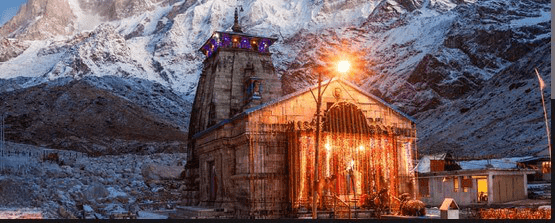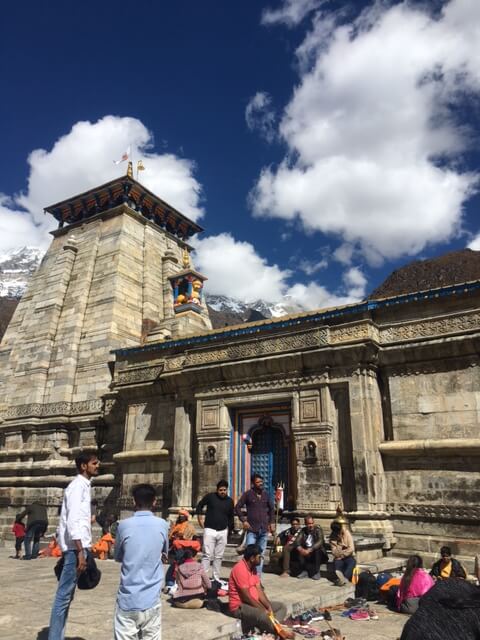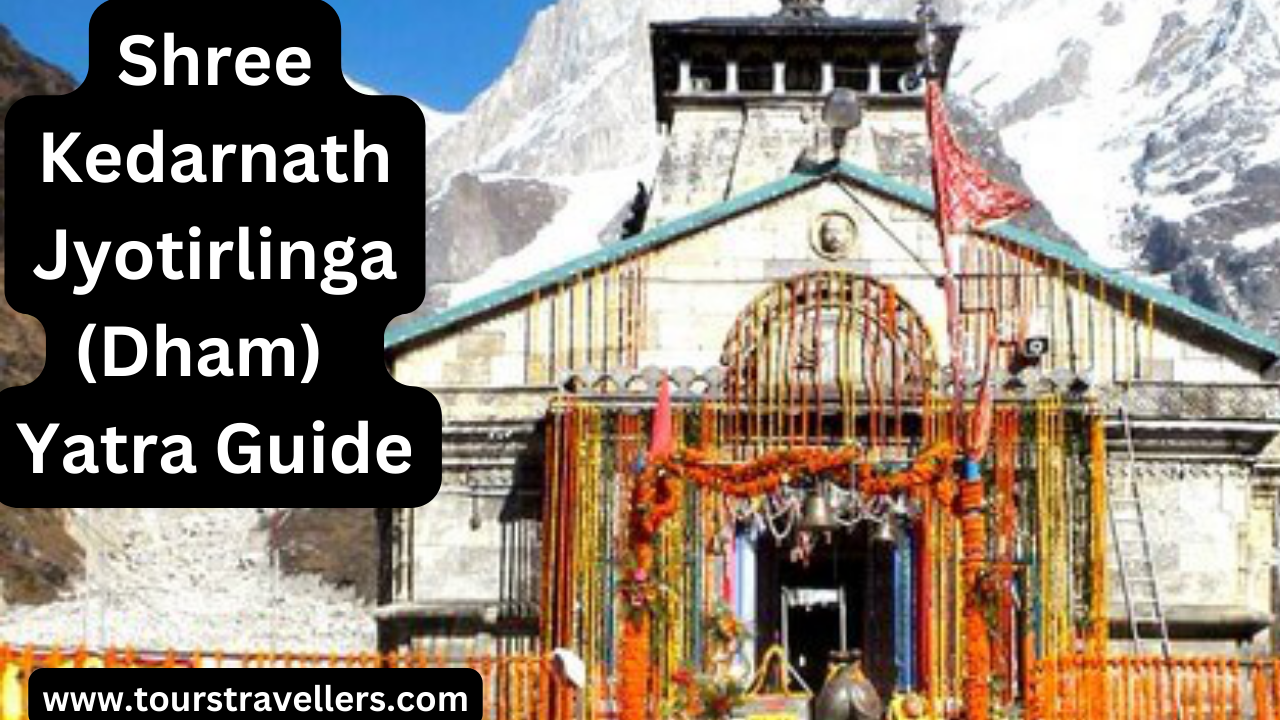Kedarnath Shivling – A Spiritual Retreat Amidst the Majestic Himalayas
Introduction:
Located on the Garhwal Himalayan range near the Mandakini River in Uttarakhand, Kedarnath stands tall as one of the most significant Shiv ling in India. Surrounded by breath-taking natural beauty, it holds immense spiritual importance. Join us on this divine journey as we unravel the wonders of Kedarnath.

The Mystique of Kedarnath Shiv ling
Kedarnath is believed to have been built by the five Pandava brothers from the Mahabharata, making it steeped in ancient mythology. Although the exact date of its construction is uncertain, this sacred temple is said to be around 3,000 years old. Due to its high altitude and extreme weather conditions, the temple remains closed for six months each year. Adjacent to the main Kedarnath temple, you’ll find the Samadhi of the revered Hindu saint, Adi Shankaracharya.
Nestled amidst the majestic Rudra Himalayan Range at an altitude of 1200 feet, Kedarnath Shiv ling is one of the four dhams of the Hindu religion. The temple is accessible only from May to June when the weather conditions are favorable. Pilgrims embarking on the Kedarnath journey often visit Gangotri and Yamunotri first, collecting holy water to offer at the sacred Shivalinga in Kedarnath.
Legend has it that in the epic Mahabharata, the Pandavas sought a place to absolve themselves of sins and attain salvation. Through their devotion, they discovered the divine Kedarnath shrine, where Lord Shiva manifested himself in the form of a magnificent triangular-shaped Jyotirlinga. It is believed that a visit to Kedarnath and the ritual bathing of the Jyotirlinga can wash away unhappiness, ill luck, and misfortunes.
Experiencing the Divine Abode
1. The Sacred Trek:
Embarking on the journey to Kedarnath is an experience in itself. The sacred trek commences from Gaurikund, a small town nestled in the foothills of the Garhwal Himalayas. The 17-kilometer trek takes pilgrims through picturesque landscapes, dense forests, and gushing waterfalls. The arduous yet rewarding trek allows devotees to connect with nature while keeping their faith steadfast.

2. Reaching Kedarnath Shivling by Helicopter:
For those seeking a more convenient mode of transportation, helicopter services are available from Phata, Guptkashi, and other nearby locations. The awe-inspiring aerial view of the Himalayas during the helicopter ride adds an extra dimension to the spiritual journey.
3. The Significance of Bathing the Kedarnath Shivling:
A sacred ritual performed by devotees involves bathing the Kedarnath Jyotirlinga. It is believed that this act washes away unhappiness, ill luck, and misfortunes. The act of devotion and purification strengthens the spiritual connection between the devotee and Lord Shiva.
Jyotirlinga Temple opening timing:
Kedarnath Shivling Temple welcomes devotees from 4 AM to 12 PM and 3 PM to 9 PM, with opening hours subject to weather conditions. The temple’s serene ambiance and spiritual aura provide a sacred space for prayer and introspection.
How to Reach:
Kedarnath can be reached by multiple modes of transportation like:
By Flight:
The nearest airport is Jolly Grant Airport in Dehradun, approximately 225 km away from Gaurikund, the starting point of the Kedarnath Shivling trek.
By Train:
Rishikesh Railway Station, located around 210 km from Gaurikund, is the nearest railhead. From there, one can hire taxis or buses to reach the starting point of the trek.
By Road:
The journey to Gaurikund can be undertaken by road through well-connected routes. Various buses and taxis / cars ply from major cities in Uttarakhand and neighboring states to Gaurikund.
From Gaurikund, which is about 17 km from the temple, pilgrims can trek or opt for mule or doli rides. Helicopter services are also available for a faster and more convenient journey.

Accommodation Options
Kedarnath Shivling offers a range of accommodation options to suit the needs of pilgrims. From simple guesthouses and dharamshalas to comfortable hotels and lodges, there are choices available for every budget. It is advisable to book your accommodation in advance, especially during the peak pilgrimage season, to ensure a hassle-free stay.
Delights of Local Cuisine:
Indulge in the flavors of Uttarakhand by savoring the local cuisine in Kedarnath. Relish traditional Garhwali dishes such as Kumaoni Raita, Aloo ke Gutke, and Bhang ki Chutney. Don’t miss the piping hot Pahadi Rajma and freshly prepared Chapatis. The simplicity and authenticity of the local cuisine add to the overall experience of your spiritual journey.
Rituals & Festivals:
Participate in the captivating rituals performed at Kedarnath Shivling Temple, including the divine Aarti ceremonies. Witness the grand celebrations during festivals like Maha Shivaratri when the temple comes alive with fervent devotion. Immerse yourself in the spiritual ambiance and feel the divine energy that permeates the air.
Shopping at Kedarnath Shivling:
For those looking for souvenirs and mementos, Kedarnath offers a variety of shops selling religious artifacts, Rudraksha beads, gemstones, and local handicrafts. Take home a piece of spirituality as a reminder of your sacred journey.
Nearby Attractions:
Rishikesh: The Gateway to Spirituality
Before embarking on the pilgrimage to Kedarnath Shivling, a visit to Rishikesh is highly recommended. Known as the “Yoga Capital of the World,” this spiritual haven offers a serene ambiance, renowned ashrams, and the opportunity to attend soul-stirring Ganga Aarti.
Tungnath Temple: The Highest Shiva Temple
Tungnath, nestled in the majestic Himalayas, is the highest temple dedicated to Lord Shiva. Located at an altitude of 3,680 meters, this ancient temple offers panoramic views of the snow-capped peaks and provides an enchanting experience for devotees and trekkers alike.
Chandrashila Peak: Touch the Celestial Heights
For adventure enthusiasts, a trek to Chandrashila Peak is a must. Situated at an altitude of 4,000 meters, this breathtaking vantage point offers awe-inspiring views of the Himalayan range and the chance to witness the sunrise casting a golden glow over the snow-clad peaks.
Guptkashi: The Hidden Gem
Guptkashi, located on the way to Kedarnath, is a place of immense religious significance. It is believed to be the place where Lord Shiva concealed himself after the battle of Kurukshetra. The ancient temples and the tranquil atmosphere make it a noteworthy stop on the pilgrimage route.
Triyuginarayan Temple: The Eternal Flame
The Triyuginarayan Temple, situated near Kedarnath, is famous for its eternal flame that has been burning for centuries. It is believed to be the place where Lord Shiva and Goddess Parvati got married. The temple’s architecture and serene surroundings attract devotees and history enthusiasts alike.
Visit to another Jyotirlinga Shree Kashi Vishwnath, Varanasi (Kashi), UP.
Safety and Travel Tips
1 Physical Preparedness:
Before embarking on the Kedarnath Shivling trek, ensure you are physically fit and consult a healthcare professional if needed. Engage in regular exercise and stamina-building activities to prepare yourself for the demanding journey.
2 Weather Considerations:
Pay close attention to weather forecasts and plan your visit during the accessible months when the temple is open. Avoid the monsoon season and extreme winter months due to the risk of landslides, heavy rainfall, and extreme cold.
3 Clothing and Equipment:
Pack warm clothing, comfortable trekking shoes, rain gear, a first aid kit, and other essential items. It is advisable to carry a walking stick or hire a mule or Doli for assistance during the trek.
4 Hydration and Altitude Sickness:
Stay hydrated throughout the journey and acclimatize yourself to the high altitude gradually. Consult a healthcare professional for guidance on preventing and managing altitude sickness.
5. Respect the temple’s sanctity and follow the instructions of the priests and authorities.
6. Be mindful of the fragile ecosystem and maintain cleanliness during your visit.
7. Register with local authorities and inform someone about your travel itinerary.
Frequently Asked Questions (FAQs)
Q. 1: What is the best time to visit Kedarnath Shivling?
Ans: The best time to visit Kedarnath Shivling is during the summer months of May to June and September to October. The weather is pleasant, and the temple is open for devotees. It is advisable to avoid the monsoon season due to the risk of landslides and heavy rainfall.
Q.2: Is it necessary to hire a guide for the trek to Kedarnath Shivling?
Ans:: While it is not mandatory, hiring a guide can be beneficial, especially for first-time trekkers. They provide valuable information about the route and ensure a safe and hassle-free journey.
Q.3: Can I take my own vehicle to Kedarnath Shivling?
Ans:: Private vehicles are not allowed beyond a certain point. You can park your vehicle at designated parking areas and continue the journey on foot, by mule, or by hiring a doli.
Q.4: Is it possible to visit Kedarnath Shivling by helicopter?
Ans: Yes, it is possible to reach Kedarnath by helicopter. Helicopter services are available from Phata, Sersi, and Guptkashi. This option is convenient for those who have limited time or physical constraints. However, it is important to book helicopter tickets in advance as they are in high demand during peak pilgrimage seasons.
Q.5: Are there any age restrictions for the trek to Kedarnath?
Ans: There are no strict age restrictions for the trek to Kedarnath. However, the trek involves steep ascents and descents, and the high altitude can be challenging for people with health issues. It is recommended to consult a healthcare professional before planning the trek, especially for elderly individuals and those with pre-existing medical conditions.
Q.6: Can I find accommodation near the temple?
Ans: Yes, there are several accommodation options available near the Kedarnath temple. These range from guesthouses and dharamshalas to tents and lodges. It is advisable to book accommodation in advance, especially during peak pilgrimage seasons, to ensure availability.
Q.7: What are the safety measures to consider during the trek?
Ans: During the trek to Kedarnath, it is important to follow safety guidelines. These include
Stay hydrated and carry sufficient water during the trek.
Wear appropriate trekking shoes and clothing to ensure comfort and protection.
Avoid overexertion and take regular breaks during the trek.
Listen to instructions from local guides and authorities.
Be aware of the weather conditions and follow any advisories or warnings.
Carry necessary identification documents and emergency contact numbers.
Q.8: What are the basic medical facilities available in Kedarnath?
Ans: Kedarnath has basic medical facilities to cater to the needs of pilgrims. There is a government hospital in Kedarnath, and medical camps are set up during the pilgrimage season. However, it is recommended to carry a first aid kit and any necessary medications with you.
Q.9: Are there any restrictions on photography or videography at the temple?
Ans: Yes, photography and videography are strictly prohibited inside the Kedarnath temple. Devotees are requested to respect the sanctity of the temple and refrain from taking photographs or recording videos inside the temple premises.
Q.10: Are there any nearby attractions apart from Kedarnath?
Ans: Yes, there are several nearby attractions that you can explore during your visit to Kedarnath. These include:
Vasuki Tal: A picturesque high-altitude lake located near Kedarnath.
Sonprayag: A scenic spot where the rivers Mandakini and Basuki Ganga meet.
Chorabari Tal: Also known as Gandhi Sarovar, it is a stunning lake surrounded by snow-clad peaks.
Gaurikund: The starting point of the trek to Kedarnath and a place of religious significance.
Q.11: Can Kedarnath be done in 1 day?
Ans: Kedarnath Trek Distance and Time
The trek can be completed in a minimum of 2 days, with a one night halt at Kedarnath, or it can be completed in a single day by experienced trekkers. The trek from Gaurikund to Kedarnath takes around 67 hours to complete, depending on the fitness level of the trekker.
Q.12: Can I go Kedarnath by own car?
Ans: Gaurikund is the nearest motorable area from Kedarnath. You can also hire a cab from Dehradun if you want to enjoy that lovely stretch at your own will. Taxis ply between Dehradun and Kedarnath and the fare varies depending upon the size/seating capacity of the vehicle.
Q.13: Can a beginner do Kedarnath trek?
Ans: A little adventure is good for the soul, and Kedarkantha is a beautiful winter trek that you can do as a beginner.
Q.14: Can we stay night at Kedarnath?
Ans: Behl Ashram Hotel in Kedarnath is the best option to stay close to the holy Kedarnath Temple. This Ashram in Kedarnath is one of the best ashrams in Kedarnath. If you are looking for a budget hotel in Kedarnath then Behl Ashram could be the best option for you.
Q.15: Can I visit Kedarnath without booking?
Ans: Kedarnath Registration is mandatory Before commencing to Yatra. here is the complete guide to do the Kedarnath registration. let us update you there is no fee involved in the Tourist registration process. make sure to carry valid personal ID proof during the kedarnath yatra.
Q.16: At which time Kedarnath is less crowded?
Ans: The best time to visit Kedarnath is during the month of May as soon as temple reopens or during September October when the crowd is less.
Q.17: In which month Kedarnath have snowfall?
Ans: March is snowbound and offers a freezing climate. Kedarnath is closed and inaccessible during March. April is very cold during evening and night and pleasant during the days. The region is covered with snow.
Q.18: Which is more difficult Kedarnath or Vaishno Devi?
Ans: The climb to the shrine from Gauri Kund, Rudrapayag is steeper than pilgrimage centres like Vaishno Devi (in Jammu) and Badrinath (which is located near Kedarnath). While there is a motorable road right up to the shrine in Badrinath, pilgrims have to walk almost 23 kilometres uphill to reach Kedarnath.
Q.19: What is the oxygen level in Kedarnath?
Ans: The oxygen depletion is measured in atmospheric pressure or percent in less oxygen. At Kedarnath, the atmospheric presence of oxygen is only 40 percent of the required level. This means that the lungs must breathe faster and the heart must pump more to retain the oxygen level in the body.
Q.20: How to register for Kedarnath Yatra?
Ans: The Kedarnath yatra registration can be done online at https://badrinathkedarnath.gov.in/, or through the official website of the Uttarakhand Government Tourist Department.
Q.21: Which is the toughest Jyotirlinga in India?
Ans: Shrikhand Mahadev is a Hindu pilgrimage site in Kullu, Himachal Pradesh, India, considered to be an abode of Lord Shiva and his wife Goddess Parvati. It is considered to be one of the toughest treks in India. The 75 feet Shivalingam at the top of the mountain is at a height of 18,570 feet.
Q.22: Can we touch Lingam in Kedarnath?
Ans: Before 3 pm the devotees can touch the shiv lingam and perform Abhishek with ghee. After 5 pm touching the idol is prohibited but the pilgrims can get a glimpse of the presiding deity from a distance where the idol of the presiding deity is dressed in an emperor costume.
Q.23: Which months Kedarnath is closing?
Ans: Every year, thousands of pilgrims visit the Kedarnath Temple to seek blessings and pay homage to Lord Shiva. The temple is usually open for visitors between the months of April to November, when the weather is relatively mild and conducive to travel.
Q.24: Is Badrinath and Kedarnath same?
Ans: Shri Kedarnath Temple, dedicated to Lord Shiva, is the eleventh out of twelve Jyotirlingas of India, while Shri Badarinath Temple is dedicated to Lord Vishnu. Both temples are situated in Garhwal Division of Uttarakhand at high altitudes in Himalayas and are believed to be established by Aadi Guru Shankaracharya.
Q.25: What are the 4 types of Dham?
Ans: The four Dhams are, Badrinath, Dwarka, Puri and Rameswaram. It is believed that every Hindu should visit the Char Dhams during one’s lifetime. The Char Dham as defined by Adi Shankara consists of four Hindu pilgrimage sites. These main ‘dhamas’ are the shrines of Vishnu and Rameshwaram is a shrine of Shiva.
Conclusion:
Embarking on a spiritual journey to Kedarnath Shivling offers a profound experience of divine connection and soulful exploration. As you traverse through the rugged terrain and immerse yourself in the mystical ambiance of the Garhwal Himalayas, the timeless legacy of Lord Shiva unfolds before you. From the sacred rituals at the temple to the enchanting nearby attractions, Kedarnath beckons devotees and wanderers alike to embrace its spiritual essence. As you bask in the blessings of the northernmost Jyotirlinga, may your journey to Kedarnath be filled with reverence, serenity, and everlasting memories.





3 thoughts on ““Kedarnath Shivling (2023)””